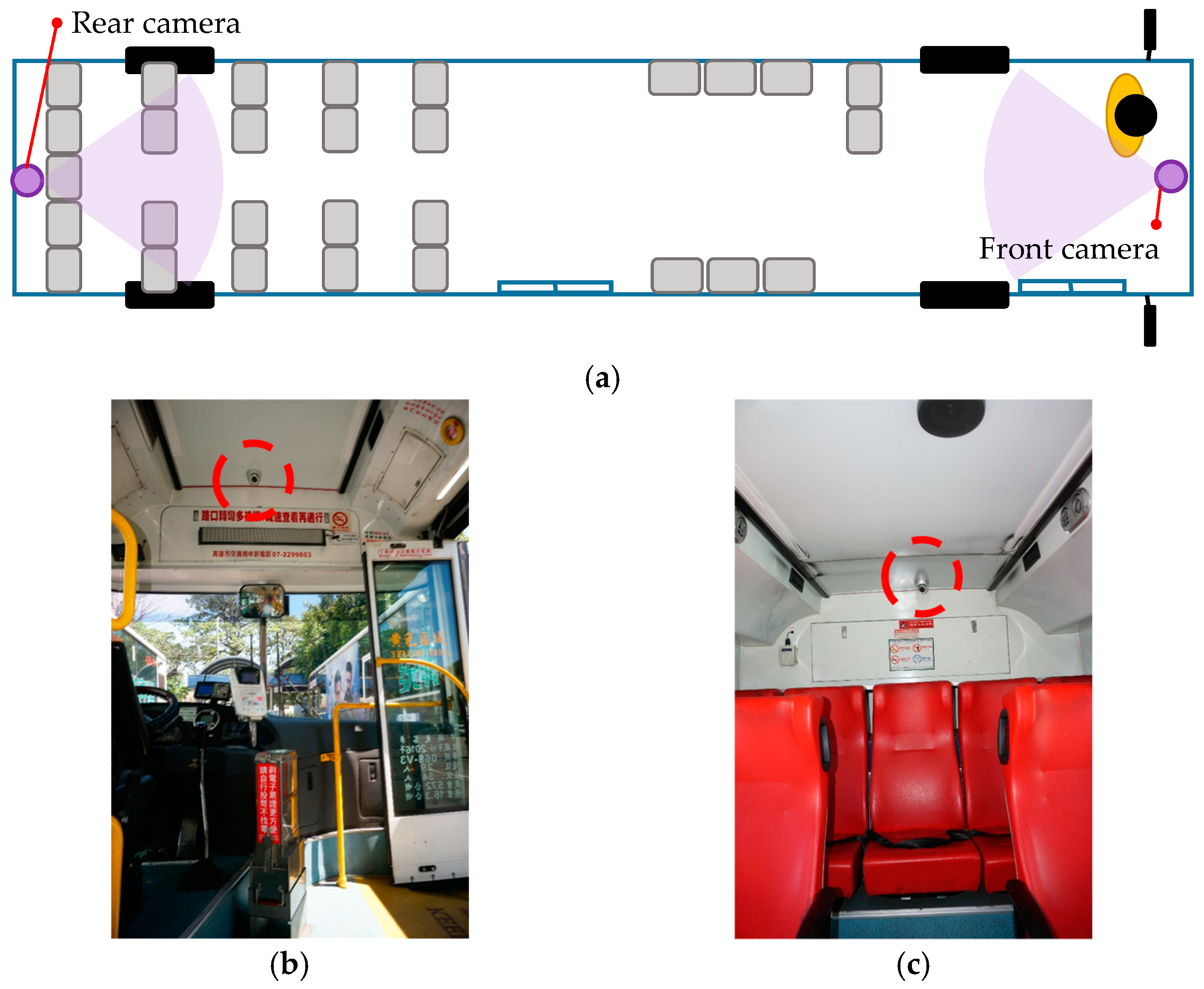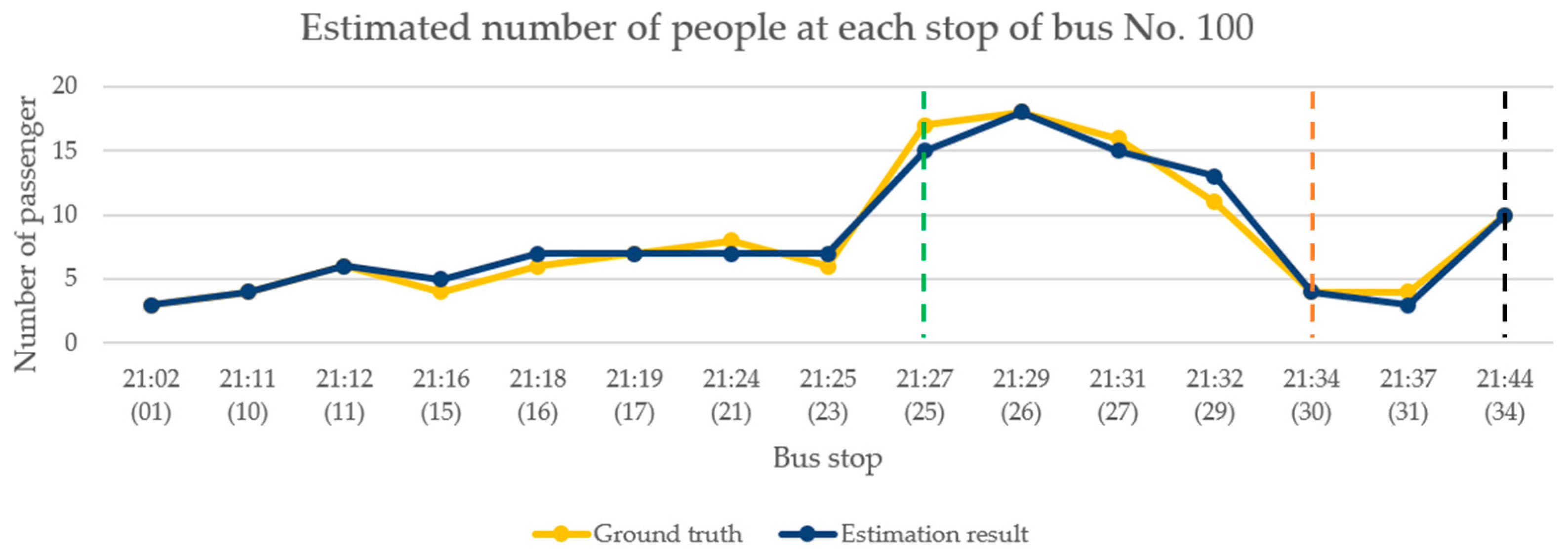Estimation of the Number of Passengers in a Bus Using Deep Learning
Abstract
1. Introduction
2. Overview of the Proposed System
2.1. Systems Architecture
- Passenger counting based on object detection: For areas where the head features of passengers are more visible, the deep learning object detection method is employed to calculate the number of passengers in the image. The you only look once version 3 (YOLOv3) network model with a high detection rate was selected.
- Passenger counting based on density estimation: We propose a CAE architecture suitable for scenarios of crowded areas on a bus. This model filters all objects in the original image that do not possess passenger characteristics and outputs the information characteristics of the passengers in the image.
2.2. Systems Database
3. Methodology
3.1. Passenger Counting Based on Object Detection
3.2. Passenger Counting Based on Density Estimation
3.2.1. Inverse K-Nearest Neighbor Map Labeling
3.2.2. Architecture of the Proposed Convolutional Autoencoder
4. Experimental Results and Discussion
4.1. Introduction to the Experimental Scene
4.2. Calculation of the Total Number of Passengers
4.3. Evaluation of Passenger Number Estimation
4.4. Evaluation of System Performance in Continuous Time
4.4.1. Estimated Results (Afternoon)
4.4.2. Estimated Results (Evening)
4.4.3. Estimated Results (Nighttime)
5. Conclusions
Author Contributions
Funding
Acknowledgments
Conflicts of Interest
References
- Luo, Y.; Tan, J.; Tian, X.; Xiang, H. A device for counting the passenger flow is introduced. In Proceedings of the IEEE International Conference on Vehicular Electronics and Safety, Dongguan, China, 28–30 July 2013. [Google Scholar]
- Oberli, C.; Torriti, M.T.; Landau, D. Performance evaluation of UHF RFID technologies for real-time passenger recognition in intelligent public transportation systems. IEEE Trans. Intell. Transp. Syst. 2010, 11, 748–753. [Google Scholar] [CrossRef]
- Chen, C.H.; Chang, Y.C.; Chen, T.Y.; Wang, D.J. People counting system for getting in/out of a bus based on video processing. In Proceedings of the International Conference on Intelligent Systems Design and Applications, Kaohsiung, Taiwan, 26–28 November 2008. [Google Scholar]
- Yang, T.; Zhang, Y.; Shao, D.; Li, Y. Clustering method for counting passengers getting in a bus with single camera. Opt. Eng. 2010, 49. [Google Scholar] [CrossRef]
- Chen, J.; Wen, Q.; Zhuo, C.; Mete, M. Automatic head detection for passenger flow analysis in bus surveillance videos. In Proceedings of the IEEE International Conference on Vehicular Electronics and Safety, Dongguan, China, 28–30 October 2013. [Google Scholar]
- Hu, B.; Xiong, G.; Li, Y.; Chen, Z.; Zhou, W.; Wang, X.; Wang, Q. Research on passenger flow counting based on embedded system. In Proceedings of the International IEEE Conference on Intelligent Transportation Systems (ITSC), Qingdao, China, 8–11 October 2014. [Google Scholar]
- Mukherjee, S.; Saha, B.; Jamal, I.; Leclerc, R.; Ray, N. A novel framework for automatic passenger counting. In Proceedings of the IEEE International Conference on Image Processing, Brussels, Belgium, 11–14 September 2011. [Google Scholar]
- Xu, H.; Lv, P.; Meng, L. A people counting system based on head-shoulder detection and tracking in surveillance video. In Proceedings of the International Conference On Computer Design and Applications, Qinhuangdao, China, 25–27 June 2010. [Google Scholar]
- Zeng, C.; Ma, H. Robust head-shoulder detection by PCA-based multilevel HOG-LBP detector for people counting. In Proceedings of the International Conference on Pattern Recognition, Istanbul, Turkey, 23–26 August 2010. [Google Scholar]
- Liu, G.; Yin, Z.; Jia, Y.; Xie, Y. Passenger flow estimation based on convolutional neural network in public transportation system. Knowl. Base Syst. 2017, 123, 102–115. [Google Scholar] [CrossRef]
- Gao, C.; Li, P.; Zhang, Y.; Liu, J.; Wang, L. People counting based on head detection combining Adaboost and CNN in crowded surveillance environment. Neurocomputing 2016, 208, 108–116. [Google Scholar] [CrossRef]
- Wang, Z.; Cai, G.; Zheng, C.; Fang, C. Bus-crowdedness estimation by shallow convolutional neural network. In Proceedings of the International Conference on Sensor Networks and Signal Processing (SNSP), Xi’an, China, 28–31 October 2018. [Google Scholar]
- Chan, A.B.; Vasconcelos, N. Bayesian Poisson regression for crowd counting. In Proceedings of the IEEE International Conference on Computer Vision, Kyoto, Japan, 29 September–2 October 2009. [Google Scholar]
- Chen, K.; Loy, C.C.; Gong, S.; Xiang, T. Feature mining for localised crowd counting. In Proceedings of the British Machine Vision Conference (BMVC), Surrey, England, 3–7 September 2012. [Google Scholar]
- Xu, B.; Qiu, G. Crowd density estimation based on rich features and random projection forest. In Proceedings of the IEEE Winter Conference on Applications of Computer Vision (WACV), Lake Placid, NY, USA, 7–10 March 2016. [Google Scholar]
- Borstel, M.; Kandemir, M.; Schmidt, P.; Rao, M.; Rajamani, K.; Hamprecht, F. Gaussian process density counting from weak supervision. In Proceedings of the European Conference on Computer Vision (ECCV), Amsterdam, The Netherlands, 11–14 October 2016. [Google Scholar]
- Chan, A.B.; Liang, Z.S.J.; Vasconcelos, N. Privacy preserving crowd monitoring: Counting people without people models or tracking. In Proceedings of the IEEE Conference on Computer Vision and Pattern Recognition, Anchorage, AK, USA, 23–28 June 2008. [Google Scholar]
- Chan, A.B.; Vasconcelos, N. Counting people with low-level features and Bayesian regression. IEEE Trans. Image Process. 2012, 21, 2160–2177. [Google Scholar] [CrossRef] [PubMed]
- Idrees, H.; Saleemi, I.; Seibert, C.; Shah, M. Multi-source multi-scale counting in extremely dense crowd images. In Proceedings of the IEEE Conference on Computer Vision and Pattern Recognition, Portland, OR, USA, 23–28 June 2013. [Google Scholar]
- Lempitsky, V.; Zisserman, A. Learning to count objects in images. In Proceedings of the International Conference on Neural Information Processing Systems (NIPS), Hyatt Regency, Vancouver, BC, Canada, 6–11 December 2010. [Google Scholar]
- Wang, J.; Wang, L.; Yang, F. Counting crowd with fully convolutional networks. In Proceedings of the International Conference on Multimedia and Image Processing (ICMIP), Wuhan, China, 17–19 March 2017. [Google Scholar]
- Zhang, C.; Li, H.; Wang, X.; Yang, X. Cross-scene crowd counting via deep convolutional neural networks. In Proceedings of the IEEE Conference on Computer Vision and Pattern Recognition (CVPR), Boston, MA, USA, 7–12 June 2015. [Google Scholar]
- Sindagi, V.A.; Patel, V.M. CNN-based cascaded multi-task learning of high-level prior and density estimation for crowd counting. arXiv 2017, arXiv:1707.09605. [Google Scholar]
- Sindagi, V.A.; Patel, V.M. Generating high-quality crowd density maps using contextual pyramid CNNs. arXiv 2017, arXiv:1708.00953v1. [Google Scholar]
- Zhang, L.; Shi, M.; Chen, Q. Crowd counting via scale-adaptive convolutional neural network. arXiv 2017, arXiv:1711.04433. [Google Scholar]
- Zhang, Y.; Zhou, D.; Chen, S.; Gao, S.; Ma, Y. Single-image crowd counting via multi-column convolutional neural network. In Proceedings of the IEEE Conference on Computer Vision and Pattern Recognition (CVPR), Las Vegas, NV, USA, 27–30 June 2016. [Google Scholar]
- Weng, W.T.; Lin, D.T. Crowd density estimation based on a modified multicolumn convolutional neural network. In Proceedings of the International Joint Conference on Neural Networks (IJCNN), Rio de Janeiro, Brazil, 8–13 July 2018. [Google Scholar]
- Huang, S.; Li, X.; Zhang, Z.; Wu, F.; Gao, S.; Ji, R.; Han, J. Body structure aware deep crowd counting. IEEE Trans. Image Process. 2018, 27, 1049–1059. [Google Scholar] [CrossRef] [PubMed]
- Sang, J.; Wu, W.; Luo, H.; Xiang, H.; Zhang, Q.; Hu, H.; Xia, X. Improved crowd counting method based on scale-adaptive convolutional neural network. IEEE Access 2019, 7, 24411–24419. [Google Scholar] [CrossRef]
- Yang, B.; Cao, J.; Wang, N.; Zhang, Y.; Zou, L. Counting challenging crowds robustly using a multi-column multi-task convolutional neural network. Signal Process. Image Commun. 2018, 64, 118–129. [Google Scholar] [CrossRef]
- Redmon, J.; Farhadi, A. Yolov3: An incremental improvement. arXiv 2018, arXiv:1804.02767. [Google Scholar]
- Olmschenk, G.; Tang, H.; Zhu, Z. Improving dense crowd counting convolutional neural networks using inverse k-nearest neighbor maps and multiscale upsampling. arXiv 2019, arXiv:1902.05379v3. [Google Scholar]
- Masci, J.; Meier, U.; Ciresan, D.; SchmidHuber, J. Stacked convolutional auto-encoders for hierarchical feature extraction. In Proceedings of the Artificial Neural Networks and Machine Learning (ICANN), Espoo, Finland, 14–17 June 2011. [Google Scholar]
- Li, Y.; Zhang, X.; Chen, D. CSRNet: Dilated convolutional neural networks for understanding the highly congested scenes. arXiv 2018, arXiv:1802.10062v4. [Google Scholar]

















| Bus Passenger Data Set (500 sets) | ||
|---|---|---|
| Method | MAE | RMSE |
| SaCNN [25] | 3.25 | 4.37 |
| MCNN [26] | 2.96 | 3.85 |
| Density-CAE | 2.31 | 2.98 |
| YOLOv3 | 2.54 | 3.17 |
| Density-CAE + YOLOv3 | 1.35 | 2.02 |
| Crowded Dataset (104 Sets) | ||
|---|---|---|
| Method | MAE | RMSE |
| YOLOv3 | 4.93 | 5.31 |
| Density-CAE + YOLOv3 | 1.98 | 2.66 |
| MAE | RMSE | |
|---|---|---|
| Density-CAE + YOLOv3 | 1.11 | 1.66 |
| MAE | RMSE | |
|---|---|---|
| Density-CAE + YOLOv3 | 1.15 | 1.52 |
| MAE | RMSE | |
|---|---|---|
| Density-CAE + YOLOv3 | 0.63 | 0.94 |
© 2020 by the authors. Licensee MDPI, Basel, Switzerland. This article is an open access article distributed under the terms and conditions of the Creative Commons Attribution (CC BY) license (http://creativecommons.org/licenses/by/4.0/).
Share and Cite
Hsu, Y.-W.; Chen, Y.-W.; Perng, J.-W. Estimation of the Number of Passengers in a Bus Using Deep Learning. Sensors 2020, 20, 2178. https://doi.org/10.3390/s20082178
Hsu Y-W, Chen Y-W, Perng J-W. Estimation of the Number of Passengers in a Bus Using Deep Learning. Sensors. 2020; 20(8):2178. https://doi.org/10.3390/s20082178
Chicago/Turabian StyleHsu, Ya-Wen, Yen-Wei Chen, and Jau-Woei Perng. 2020. "Estimation of the Number of Passengers in a Bus Using Deep Learning" Sensors 20, no. 8: 2178. https://doi.org/10.3390/s20082178
APA StyleHsu, Y.-W., Chen, Y.-W., & Perng, J.-W. (2020). Estimation of the Number of Passengers in a Bus Using Deep Learning. Sensors, 20(8), 2178. https://doi.org/10.3390/s20082178





